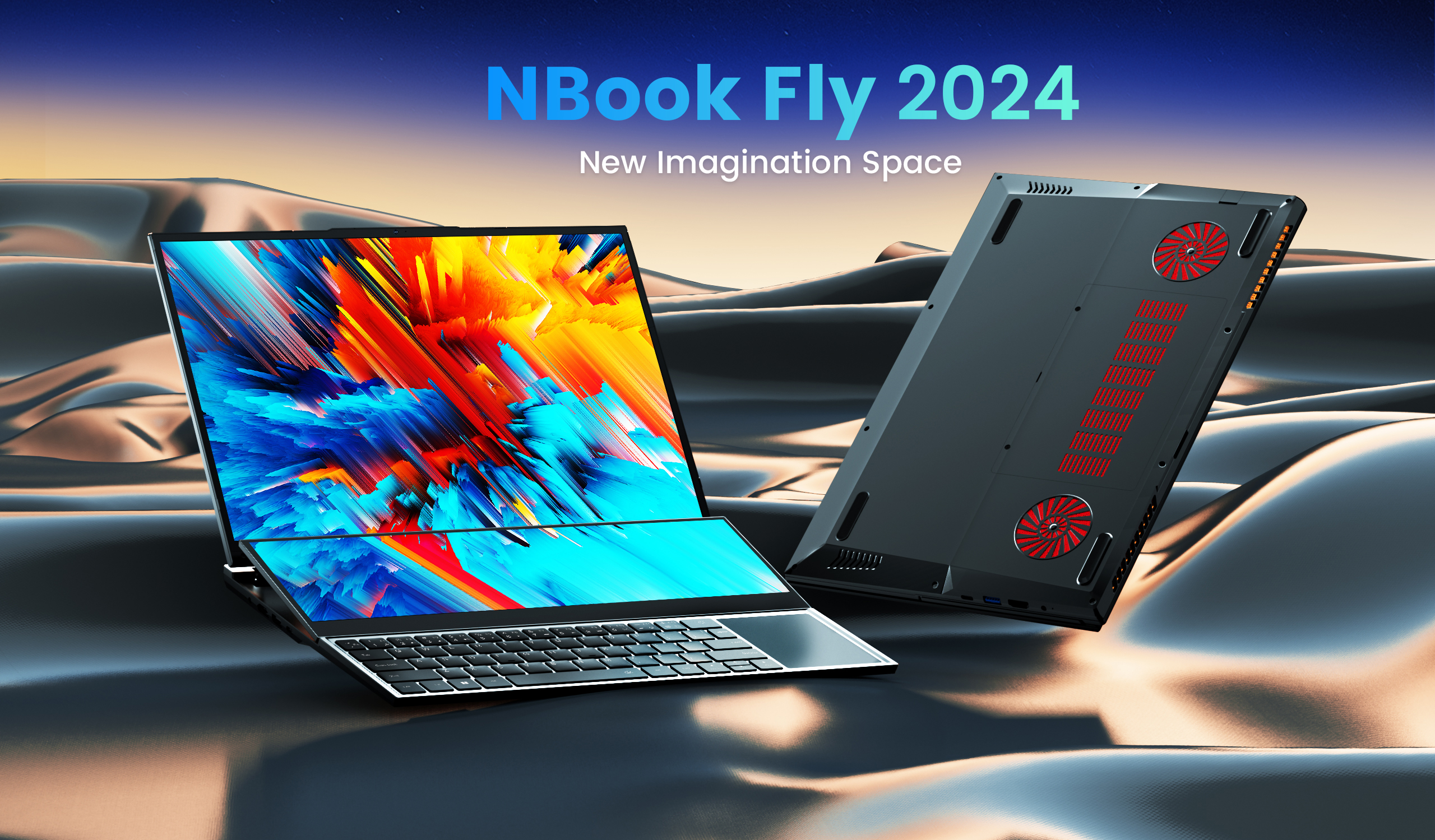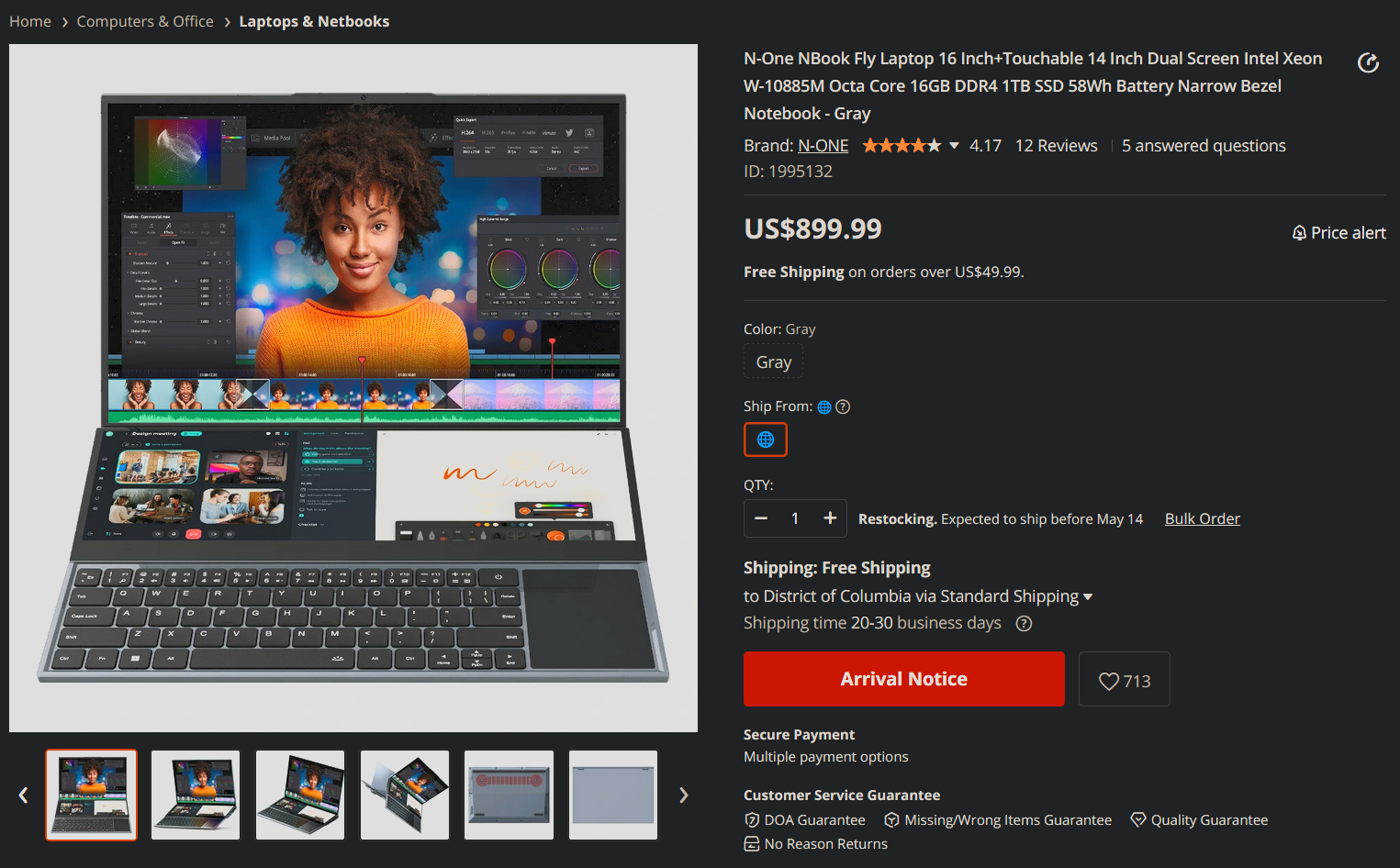$899 Dual-screen NBook Fly laptop gets 'upgraded' to a 2020-era Comet Lake Xeon CPU
It's priced attractively, but there are compromises.

Chinese device maker N-one has revised its NBook Fly laptop series with a new Comet Lake-based Xeon processor, but it's arguably not a significant upgrade from earlier specifications, as revealed by Notebookcheck. If you crave more visual workspace for multitasking, this laptop's dual-screen design is sure to appeal. At just $899, it's quite reasonably priced given the features, but the dated processor and lack of a dedicated GPU might be a significant compromise, depending on your workflow. And that's not to mention the potential for duties and tariffs that may drive the price well above $,1000.
N-one is a rather niche Chinese brand that specializes in laptops, tablets, and mini-PCs, with limited distribution and products available globally. Even the laptop in question today is only available from Banggood, which is a Chinese direct-to-consumer online retailer. The brand offers several laptop models, including dual-screen and traditional clamshell designs, to meet the needs of most consumers.
N-one's NBook Fly family is a competitor the Asus Duo product line. So far, the only model in N-one's lineup includes CPUs based on architectures that are half a decade old, which is obviously far from ideal. The NBook Fly originally featured a 14nm fabbed i7-10850H CPU with 6 cores / 12 threads, based on Intel's Comet Lake architecture. The revised model upgrades this to a Xeon W-10885M, wielding 8 cores / 16 threads based on the same design, with faster clock speeds, support for ECC memory, and workstation-optimized iGPU drivers.

The key selling point is the dual-screen design, featuring a primary 16-inch 1920x1200 display atop a secondary 14.1-inch 3840x1110 touchscreen (both IPS) that automatically deploys when you open the laptop. Beneath that is a standard keyboard with a touchpad to the right. The laptop comes configured with 16GB of DDR4 memory and a 1TB SSD, with two SODIMMs and two M.2 2280 SSD slots in total. Connectivity technologies are slightly behind the curve, featuring Wi-Fi 5 and Bluetooth 4.2.
The NBook Fly includes one USB Type-C port, three USB 3.0 ports (likely Type-A), one HDMI port, a 3.5mm jack for audio, and an RJ45 (1,000 Mbps) Ethernet port. Charging is handled by a barrel port, as seen in several user reviews. The battery is rated at 58Wh, which should be enough for at least a few hours of use.
In short, while it's interesting, this laptop doesn't have much going for it apart from the dual-screen display. Giving credit where it's due, the NBook Fly is still significantly more affordable than dual-screen equivalents from Lenovo or Asus. Be aware that not every review of the NBook Fly has been positive, with several users reporting issues related to the screens.
If you subtract the dual-screen design from the equation, there are many better options available locally with modern-day Ryzen AI 300/200 or Core Ultra 200 processors, which are far better in most respects than the Xeon you're getting here. Some laptops in this price range even include a dedicated GPU. If you're after battery life, consider laptops with Intel's Lunar Lake, which are often available under the $1,000 price point, or maybe get a MacBook if that suits your needs.
Stay On the Cutting Edge: Get the Tom's Hardware Newsletter
Get Tom's Hardware's best news and in-depth reviews, straight to your inbox.
Follow Tom's Hardware on Google News to get our up-to-date news, analysis, and reviews in your feeds. Make sure to click the Follow button.

Hassam Nasir is a die-hard hardware enthusiast with years of experience as a tech editor and writer, focusing on detailed CPU comparisons and general hardware news. When he’s not working, you’ll find him bending tubes for his ever-evolving custom water-loop gaming rig or benchmarking the latest CPUs and GPUs just for fun.
-
abufrejoval These small Chinese companies just practice extreme recyling or rather extreme clearout sale engineering, since the parts they use very likely have never been used, but lain in storage until the last long term support warranty from Intel had expired.Reply
Well, perhaps some of them actually have been used before, but you might not been able to tell.
I find it even more fascinating, that these Intel parts were actually made: who did they think would fall for that sort of a thing, except those few, who couldn't forego ECC support even on a laptop for reasons of reliablity?
Military or space applications come to mind, even if it just meant that these perfectly binned parts had just didn't have their ECC fuses blown.
Today they sell for pennies, because that's still better than putting them into a landfill.
The chassis: probably these are original parts, too. Just another"cool" product, that didn't meet sales projections.
Comet Lake ran hot! I only have an i7-10700U hexacore in a NUC, but that CPU likes to burn those 45 Watts just to keep those cores clocking, while they deliver probably much less than your Zen2 or 3 APUs. And that iGPU? Last of the HD lineage, effectively 2D, only. Driver development for anything pre-Xe has stopped, but gaming isn't what you'd do on these.
It's a flashy show off, much like a fiberglass Lamborghini Murciélago lookalike with an i4 Honda engine. I guess that works in some places, otherwise they wouldn't exist. And as long as you don't try to use it for long without a wall plug, it might be allright... if it runs Windows 11.
The link no longer works but I'm pretty sure the RAM is soldered and doesn't support ECC...